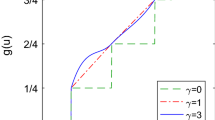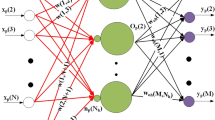Abstract
This paper demonstrates how the p-recursive piecewise polynomial (p-RPP) generators and their derivatives are constructed. The feedforward computational time of a multilayer feedforward network can be reduced by using these functions as the activation functions. Three modifications of training algorithms are proposed. First, we use the modified error function so that the sigmoid prime factor for the updating rule of the output units is eliminated. Second, we normalize the input patterns in order to balance the dynamic range of the inputs. And third, we add a new penalty function to the hidden layer to get the anti-Hebbian rules in providing information when the activation functions have zero sigmoid prime factor. The three modifications are combined with two versions of Rprop (Resilient propagation) algorithm. The proposed procedures achieved excellent results without the need for careful selection of the training parameters. Not only the algorithm but also the shape of the activation function has important influence on the training performance.




Similar content being viewed by others
References
Haykin S (1999) Neural networks: a comprehensive foundation, 2nd edn. Prentice-Hall, Upper Saddle River
Pao YH (1989) Adaptive pattern recognition and neural networks. Addison-Wesley, Reading
Kwan HK (1992) Simple sigmoid-like activation function suitable for digital hardware implementation. IEE Electron Lett 28(15):379–1380
Zhang M, Vassiliadis S, Delgado-Frias JG (1996) Sigmoid generators for neural computing using piecewise approximation. IEEE Trans Comput 45(2):1045–1049
Basterretxea K, Tarela JM, del Campo I (2002) Digital design of sigmoid approximation for artificial neural networks. IEE Electron Lett 38(1):35–37
Piazza A (1992) Neural networks with digital LUT activation function. In: Proceedings of 1993 international joint conference on neural networks (IJCNN’93), vol 2, Nagoya, Japan, 25–29 October 1993
Piazza A, Uncini A, Zenobi M (1992) Artificial neural networks with adaptive polynomial activation function. In: Proceedings of the international joint conference on neural networks (IJCNN), Beijing, China
Guarnieri S, Piazza F, Uncini A (1999) Multilayer feedforward networks with adaptive spline activation function. IEEE Trans Neural Netw 10(3):672–683
Vecci L, Piazza F, Uncini A (1998) Learning and approximation capabilities of adaptive spline neural networks. Neural Netw 11(2):259–270
Ampazis N, Perantonis SJ (2002) Two highly efficient second-order algorithms for training feedforward networks. IEEE Trans Neural Netw 13(5):1064–1074
Fukuoka Y, Matsuki H, Minamitani H, Ishida A (1998) A modified back-propagation method to avoid false local minima. Neural Netw 11(6):1059–1072
Lee H-M, Chen C-M, Huang T-C (2001). Learning efficiency improvement of back-propagation algorithm by error saturation prevention method. Neurocomputing 41(1–4):125–143
Ng S-C, Cheung C-C, Leung S-H (2003) Integration of magnified gradient function and weight evolution with deterministic perturbation into back-propagation. IEE Electron Lett 39(5):447–448
Rumelhart DE, Hinton GE, Williams RJ (1986) Learning internal representations by error propagation. In: Rumelhart DE, McClelland JL (eds) Parallel distributed processing: exploration in the microstructures of cognition, MIT Press, Cambridge, pp 318–362
Joost M, Schiffmann W (1998) Speeding up backpropagation algorithms by using cross-entropy combined with pattern normalization. Int J Uncertainty Fuzzyness Knowl-Based Syst 6(2):117–126
van Ooyen A, Nienhuis B (1992) Improving the convergence of the backpropagation algorithm. Neural Netw 5:465–471
Oh S-H (1997) Improving the error backpropagation algorithm with a modified error function. IEEE Trans Neural Netw 8(3):799–803
Hertz J, Krogh A, Palmer RG (1991) Introduction to the theory of neural computation. Addison-Wesley, Redwood City
Palmieri F, Catello C, D’Orio G (1999) Inhibitory synapses in neural networks with sigmoidal nonlinearities. IEEE Trans Neural Netw 10(3):635–644
Riedmiller M, Brun H (1993) A direct adaptive method for faster backpropagation learning: The RPROP algorithm. In: Proceedings of the IEEE international conference on neural networks, vol 1, San Francisco, 28 March–1 April 1993
Igel C, Huesken M (2003) Empirical evaluation of the improved rprop learning algorithms. Neurocomputing 50:105–123
Treadgold NK, Gedeon TD (1998) Simulated annealing and weight decay in adaptive learning: the SARPROP algorithm. IEEE Trans Neural Netw 9(4):662–668
Gorman RP, Sejnowski TJ (1988) Analysis of hidden units in a layered network trained to classify sonar targets. Neural Netw 1:75–89
Karayiannis NB (1996) Accelerating the training of feedforward neural networks using generalized hebbian rules for initializing the internal representations. IEEE Trans Neural Netw 7(2):419–426
Mandischer M (2002) A comparison of evolution strategies and backpropagation for neural network training. Neurocomputing 42(1–4):87–117
Fahlman SE (1998) An empirical study of learning speed in back-propagation networks. Technical report CMU-CS-88-162, School of Computer Science, Carnegie Mellon University, Pittsburgh, USA
Rujan P (1997) Playing billiards in version space. Neural Comput 9:99–122
Torres Moreno JM, Gordon MB (1998) Characterization of the sonar signals benchmarks. Neural Process Lett 7(1):1–4
Perantonis SJ, Virvilis V (1999) Input feature extraction for multilayered perceptrons using supervised principal components analysis. Neural Process Lett 10(3):243–252
Hasenjäger M, Ritter H (1999) Perceptron learning revisited: the sonar targets problem. Neural Process Lett 10(1):1–8
Battiti R (1992) First and second-order methods for learning: between steepest descent and Newton’s method. Neural Comput 4(2):141–166
Battiti R (1989) Accelerated backpropagation learning: two optimization methods. Complex Syst 3:331–342
Johansson EM, Dowla FU, Goodman DM (1991), Backpropagation learning for multilayer feed-forward neural networks using the conjugate gradient method. Int J Neural Syst 2(4):291–301
Hagan MT, Menhaj M (1994) Training feedforward networks with the Marquardt algorithm. IEEE Trans Neural Netw 5(6):989–993
Tesauro G, Janssens B (1988) Scaling relationships in backpropagation learning. Complex Syst 2:39–84
Yang J-M, Kao C-Y (2001) A robust evolutionary algorithm for training neural networks. Neural Comput Applic 10(3):214–230
Whitley D, Karunanithi N (1991) Generalization in feedforward neural networks. In: IJCNN-91-Seattle international joint conference on neural networks (IJCNN’91), vol 2, Seattle, 8–14 July 1991
Perrone MP, Cooper LN (1993) When networks disagree: ensemble methods for hybrid neural networks. In: Mamone RJ (ed) Neural Networks for Speech and Image Processing, Chapman Hall, London, pp 126–142
Jiang J (1999) Image compression with neural network: a survey. Signal Process Image Commun 14(9):737–760
Cybenko G (1989) Approximation by superposition of a sigmoid function. Math Control Signal Syst 2(4):303–314
Chen DS, Jain RC (1994) A robust back propagation learning algorithm for function approximation. IEEE Trans Neural Netw 5(3):467–479
Acknowledgments
This work was supported by the Thailand Research Fund (TRF).
Author information
Authors and Affiliations
Corresponding author
Rights and permissions
About this article
Cite this article
Sunat, K., Lursinsap, C. & Chu, CH.H. The p-recursive piecewise polynomial sigmoid generators and first-order algorithms for multilayer tanh-like neurons. Neural Comput & Applic 16, 33–47 (2007). https://doi.org/10.1007/s00521-006-0046-x
Received:
Accepted:
Published:
Issue Date:
DOI: https://doi.org/10.1007/s00521-006-0046-x




